

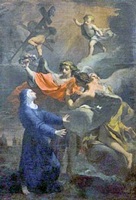
Panel (1791) by Gaetano Gandolfi
of a vision of Angela of Foligno
San Francesco, Foligno
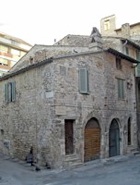
Angela led what she later regarded as a sinful life until what seems to have been a sudden conversion in ca. 1285. This might have been the result of an encounter with the Blessed Peter Crisci: she records that "I used to make fun of a certain Petruccio, but now I could not do otherwise than follow his example". She was too ashamed to make a full confession until St Francis appeared to her in a vision and exhorted her to true repentance. Under his guidance, she chose Brother Arnold (a Franciscan friar who seems to have been related to her) as her confessor.
Blessed Angela then began a life of penance, prayer and (despite her marital status) celibacy. When her husband and children died suddenly (presumably in an epidemic) in ca. 1288, she became the leading light in a fraternity of lay men and women that had been formed in 1270 at San Francesco. This community subsequently belonged to the Franciscan Third Order.
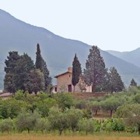
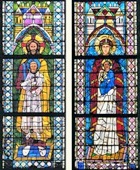
Once back in Foligno, Blessed Angela explained to Fra Arnaldo how she had been feeling during her vision. He was initially sceptical, but when he realised the depth of this and other of her mystical experiences, he began to write a Latin account, the “Memoriale” in Latin, taking dictation in her Umbrian dialect This work was complete by 1298. It circulated quite widely and, as a result, Blessed Angela became influential, particularly among those Franciscan friars who were working to reform the Order. She wrote or dictated letters to many of them, giving advice on the spiritual life. After her death, these were collected into what is now called her Instructiones.
Angela died in 1309 and was buried in San Francesco. Her tomb immediately became the focus of a cult. Brother Arnold wrote her biography, but despite the support of influential cardinals and despite the miracles reported at her tomb, she does not seem to have been the subject of a formal process of canonisation. However, Pope Clement XI confirmed her cult in 1701.
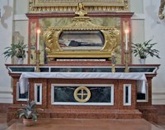
The relics of the Blessed Angela were kept inside a wooden reliquary until the 20th century, when they were transferred to the present reliquary, on the 2nd altar on left of San Francesco. (The altarpiece of this altar is illustrated at the top of the page.) [They have been temporarily transferred to the Oratorio del Gonfalone while the church is repaired after the earthquake of 2016.]

Return to Saints of Foligno.

